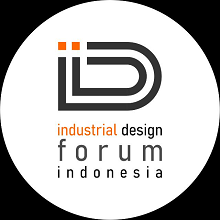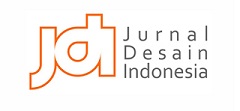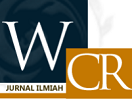PENERAPAN MOTIF ARABES MASJID MANTINGAN SEBAGAI UNSUR ESTETIKA PADA WALL FOLDING DESK
Abstract
Indonesia has a wide variety of art crafts, one example is carving. Art in the form of carving can be found in Jepara Regency, known internationally for its beautiful quality. History records that Jepara carving began in the 16th century which can be seen in the ornaments of the Mantingan Mosque. The purpose of this research is to apply one of the Mantingan Mosque ornaments, namely arabesque motif, as an aesthetic element on a wall folding desk furniture. The wall folding desk is chosen for its multifunctionality, therefore can act as an alternative choice for homes or spaces with limited sizes. This wall folding desk furniture is equipped with lights, electrical terminals, and storage boxes as an effort to meet consumer needs. The product design process of this research refers to a qualitative approach using the design thinking method. The results of this study are in the form of product designs, technical drawings, and wall folding desk furniture products that apply the arabesque motif of the Mantingan Mosque. The expected benefits of this research are in the form of perseverance effort of the arabesque motif of the Mantingan Mosque as the forerunner of Jepara carving and the additional aesthetic value of the application of the Arabes motif of the Mantingan Mosque of the product.
Keywords
Full Text:
PDF (Bahasa Indonesia)References
Ahmad, M., Rashid, K., & Naz, N. (2018). Study of the ornamentation of Bhong Mosque for the survival of decorative patterns in Islamic architecture. Frontiers of Architectural Research, 7(2), 122–134.
Andini, D. R., & Rosandini, M. (2017). Pengolahan Motif Dari Inspirasi Ornamen Tamansari Keraton Yogyakarta. Atrat, 5(9), 255–265.
Anindyta, H. (2017). Pengaruh Kebudayaan Cina terhadap Arsitektur Masjid Mantingan. A207–A212.
Arifin, Z., Widagdo, J., & Bagus, F. (2020). Budaya Rupa Motif Ukir Masjid Mantingan Pada Mebel Ukir. Jurnal Imajinasi, XIV(2).
Arnita, T. (2016). Apresiasi seni: Imajinasi dan kontemplasi dalam karya seni. Penelitian Guru Indonesia-JPGI, 1(1), 52.
Asy’ari, M. (2017). Islam dan Seni. Hunafa, 4(2), 1–6.
Atmadi, T. (2017). Kajian desain interior kantor PT. Pupuk sriwidjaja dengan konsep modern minimalism. Narada, 4(3), 303-313.
Bagus, F., Widagdo, J., & Arifin, Z. (2019). Bentuk Rupa dan Makna Simbolik Motif Ukir pada Masjid Mantingan Jepara dalam Konteks Sosial Budaya. Jurnal Imajinasi, 13(2), 56–64.
Fariyanto, F., Suaidah, & Ulum, F. (2021). Perancangan Aplikasi Pemilihan Kepala Desa dengan Metode UX Design Thinking (Studi Kasus : Kampung Kuripan), 2(2), 52-60.
H, R., & Ismail. (2016). Desain Meja Makan Lipat untuk Apartemen Pandan Wangi Tipe 21. Kreatif, 3(2), 41–49.
Irawan, B., & Tamara, P. (2013). Dasar - Dasar Desain. Griya Kreasi.
Jamaludin. (2022). Pengantar Desain Mebel. Kiblat Buku Utama.
Kurniawan, A., & Hidayatullah, R. (2016). Estetika Seni. In Estetika Seni (Issue February). https://www.researchgate.net/publication/332652425_ESTETIKA_SENI
Kusumowardhani, P. (2018). Analisis Motif Ragam Hias Batik Jawa Tengah Berbasis Unsur Visual Bentuk dan Warna (Studi Kasus Batik Semarang dan Pekalongan). Narada, 5(2), 291075.
Mulyadi, M. (2021). Analisa Sistem Kerja Meja dan Kursi Lipat untuk Luar Ruang. Narada, 8(1), 101-112.
Na’am, M. F. (2015). Ornaments in Mantingan Mosque and Tomb: Analysis of Form, Funtion, and Symbolic Meaning. http://conf.unnes.ac.id/index.php/uicric/uicric2015
Nirmala, A. P. H., Violaningtyas, O. A., & Damayanti, R. A. (2019). Ornamen Islam Pada Bangunan Arsitektur Masjid Dian Al Mahri Kubah Emas Depok. Jurnal Dimensi Seni Rupa Dan Desain, 16(1), 29.
Othman, R., & Zainal-Abidin, Z. J. (2011). The importance of Islamic art in mosque interior. Procedia Engineering, 20, 105–109.
Pintono, T., Tulistyantoro, L., & Suprobo, F. P. (2018). Perancangan Mebel Multifungsi untuk Apartemen Mahasiswa Desain. Jurnal Intra, 6(2), 807–812.
Pratiwia, A. P., Kenang, K. K., & Ruki, U. A. (2017). Analisa Perkembangan Motif Ukiran Di Jepara Pada Abad Ke-16 Hingga Abad Ke-17. 2. Kreasi, 2(2), 5–25.
Priyatno, A. (2015). Seni Rupa Timur. In UNIMED PRESS: Vol. ث ققثق (Issue ثق ثقثقثق).
Putrie, Y. E., & Hosiah, A. (2012). Keindahan Dan Ornamentasi Dalam Perspektif Arsitektur Islam. Journal of Islamic Architecture, 2(1).
Setiawan, A. (2009). Ornamen Mesjid Mantingan di Jepara Jawa Tengah. Institut Seni Indonesia.
Setiawan, A., & Sulaiman, A. M. (2017). Pengembangan Desain Motif Ukir untuk Aktualisasi Identitas Jepara sebagai Kota Ukir. ANDHARUPA: Jurnal Desain Komunikasi Visual & Multimedia, 31-48.
Suhartini. (2020). Pengembangan Produk Meja Belajar Multifungsi Dengan Menggunakan Metode Quality Function Deployment Dan Antropometri. Jurnal Tecnoscienza, 4(2), 301–318.
Supatmo, & Syafii. (2019). Nilai Multukultural Ornamen Tradisional Masjid-Masjid Warisan Para Wali Di Pesisir Utara Jawa. Imajinasi : Jurnal Seni, 13(2), 1–14.
Wijaya, C., Kusumarini, Y., & Suprobo, F. P. (2015). Perancangan Portable Folding Furniture untuk Interior Apartemen Tipe Studio. Jurnal Intra, 3(2), 9–17.
Zain, M. I. H. (2018). Kontekstualisasi Hadis Larangan Menggambar dengan Desain Grafis. Riwayah: Jurnal Studi Hadis, 4(1), 101-124
DOI: http://dx.doi.org/10.22441/narada.2023.v10.i1.004
Refbacks
- There are currently no refbacks.
Fakultas Desain dan Seni Kreatif
Universitas Mercu Buana
Gedung E Lantai 4
Jl. Raya Meruya Selatan no.1, Kembangan, Jakarta 11650
Tlp./Fax: +62215871335
Journal International Standard Serial Number (ISSN) Registration:
The Journal is indexed by:
Tools for Citations & Plagiarism Detection:

Ciptaan disebarluaskan di bawah Lisensi Creative Commons Atribusi-NonKomersial 4.0 Internasional
 NARADA: Jurnal Desain dan Seni
NARADA: Jurnal Desain dan Seni

























